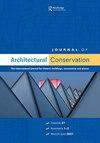A tool for identifying post-Intervention value shifts in urban heritage places: the Heritage Value Circle
IF 0.5
3区 艺术学
0 ARCHITECTURE
引用次数: 5
Abstract
ABSTRACT Heritage places become the focus of interventions due to their socio-cultural and economic values, but as value assessments are subjective, these values can be interpreted differently by decision-makers when considering interventions. Different interpretations of values may result in different interventions, leading to the transformation of the physical, social, and economic features of urban heritage places, and consequently, to changes in their socio-cultural and economic values. Identifying value shifts can help in the recognition of the impact of interventions on the preservation, and thus sustainability, of heritage places. Considering the contemporary debates around the issue of sustainability, this study aims to identify the link between impact assessments and sustainable development by answering the following question: ‘How can post-intervention value shifts be identified to assess the impact of the intervention on the sustainability of heritage places?’ To answer this question, the study introduces a qualitative impact assessment tool: the Heritage Value Circle (HVC), which is based on the examination of urban interventions in different contexts, and a content analysis of the policy documents related to heritage conservation of various NGOs and IGOs. The study identifies seven components of interventions and defines correlation between interventions, pillars of sustainability and values.识别干预后城市遗产地价值变化的工具:遗产价值圈
摘要遗产地由于其社会文化和经济价值而成为干预措施的焦点,但由于价值评估是主观的,决策者在考虑干预措施时可能会对这些价值进行不同的解释。对价值观的不同解释可能导致不同的干预措施,导致城市遗产地的物理、社会和经济特征的转变,从而导致其社会文化和经济价值观的变化。识别价值转变有助于认识到干预措施对遗产地的保护以及可持续性的影响。考虑到当代围绕可持续性问题的争论,本研究旨在通过回答以下问题来确定影响评估与可持续发展之间的联系:“如何确定干预后的价值转变,以评估干预对遗产地可持续性的影响?”为了回答这个问题,本研究引入了一个定性影响评估工具:遗产价值圈(HVC),该工具基于对不同背景下城市干预措施的审查,以及对各种非政府组织和政府间组织与遗产保护相关的政策文件的内容分析。该研究确定了干预措施的七个组成部分,并定义了干预措施、可持续性支柱和价值观之间的相关性。
本文章由计算机程序翻译,如有差异,请以英文原文为准。
求助全文
约1分钟内获得全文
求助全文

 求助内容:
求助内容: 应助结果提醒方式:
应助结果提醒方式:


